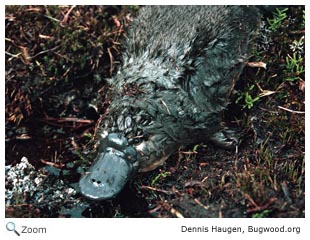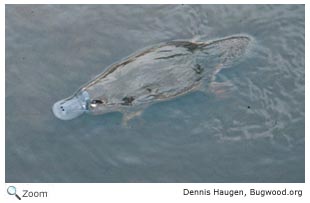Ornithorhynchidae - Duck-billed Platypus |
|
|
 The duck-billed platypus is the only species in this family. It is found in eastern Australia. The duck-billed platypus is 19-22 inches in length and it looks like it is made up of pieces of other animals! It has thick, waterproofed brown fur; a flat, round and flexible black snout that looks like a duck's bill; a flat, rounded, beaver-like tail; and webbed feet. The duck-billed platypus is the only species in this family. It is found in eastern Australia. The duck-billed platypus is 19-22 inches in length and it looks like it is made up of pieces of other animals! It has thick, waterproofed brown fur; a flat, round and flexible black snout that looks like a duck's bill; a flat, rounded, beaver-like tail; and webbed feet.
The male duck-billed platypus has a
venomous spur on his ankle that he uses when he is threatened by predators or other male duck-billed platypuses. The make attacks with the spur and injects venom into his attacker. The venom is strong enough to kill small predators and cause pain to larger ones.
The duck-billed platypus lives in burrows near lakes, ponds, streams, and rivers. It swims under water to locate insects, crustaceans, and mollusks.
 The duck-billed platypus uses electricity to locate its food. Its bill detects the small electrical currents put out by creatures swimming in the water. It scoops up its prey from the muddy water, uses its bill to strain out the water, and then stores the food in its cheeks. The duck-billed platypus uses electricity to locate its food. Its bill detects the small electrical currents put out by creatures swimming in the water. It scoops up its prey from the muddy water, uses its bill to strain out the water, and then stores the food in its cheeks.
The female duck-billed platypus lays 1-3 leathery eggs. The eggs incubate for 6-10 days. The female cares for the young and produces milk that is secreted though her skin. The young platypuses lick the milk off their mother.
World Status Key
 Least Concern Least Concern  Near Threatened Near Threatened  Vulnerable Vulnerable  Endangered Endangered  Critically Endangered Critically Endangered  Extinct in Wild Extinct in Wild  Extinct Extinct
Status and range is taken from ICUN Redlist. If no status is listed, there is not enough data to establish status.
US Status Key
 Threatened in US Threatened in US  Threatened in NH Threatened in NH  Endangered in US Endangered in US  Endangered in NH Endangered in NH  Introduced Introduced
Status taken from US Fish and Wildlife and NH Fish and Game
Location Key
 Africa Africa  Asia Asia  Australia/Oceania Australia/Oceania  Europe Europe  North America North America  South America South America  NH NH  Click for More Info Click for More Info  Click for Image Click for Image
New Hampshire Species
|
|
North/Central American Species
|
None
|
|
None |
|


